Lost Lover: what would we say if we could tell the story
In the text “Can non-Europeans think?”, Hamid Dabashi questions the affirmation of the European epistemological superiority and the globalization of its universal way of thinking. The author asks for the reason why we consider philosophy to be European, and European only, whereas African philosophy is demoted to ethno-philosophy. Furthering this line of questioning, Dabashi wonders what happens to thinkers that operate outside of the European legitimate philosophical regime?
This ethnographic gaze, with its confidence and totalitarianism, embodies one of the Empire’s many shades of intellectual arrogance, that disqualifies a multiplicity of modes of thought, as well as the places where they originate, in defense of a pretense totalitarian universality of thought.
The exhibition Lost Lover speaks about the political, historical and geographical conditions through which knowledge is produced and controlled. The screening program assembled by Lara Koseff was originally presented in Rio de Janeiro, in the courtyard of Lanchonete, now in Rampa, Porto.
In the front room, 11 single-channel video pieces are projected in a loop. The authors, who are mostly from South Africa, confront us with the abandon of fear, thus calling to action topics that are often and strategically silenced.
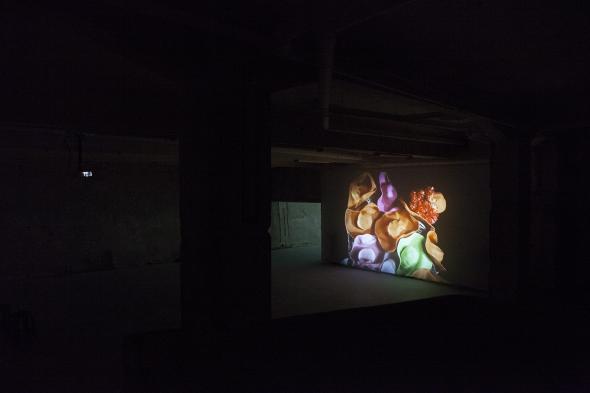 The Purge, 2013, de Athi-Patra Ruga
The Purge, 2013, de Athi-Patra Ruga
The Purge de Athi-Patra Ruga, 2013, forces us into the analytical dimension of slow-motion through which the construction of an utopian identity takes place as psycho-geographic difference. In the post-apartheid period, the body finds affirmation as tool for interrogation, subversive strategy and battlefield. As a place for chaos, the body becomes a public entity, a common good, a conceptual stage where contradictory ideologies related to the social, the political and the sexual collide. Through mesmerizing explosions of color, paint filled balloons blow up in dialogue with the implied birth of a flower, becoming a sign for collective and individual memory. Along the way, a gong sound paces the tragic order and the search for a sense of unity. In this political body history is inscribed through misshapes and catharsis, sickness and healing. The power of passions is not proprietary nor exclusive and thus becomes the hidden strength that intensifies the combat.
Regressing into from childhood memories, Lungiswa Gqunta returns to her grandmother and sister’s house to question the structure that supports the South-African regime. In Feet Under Fire, 2017, the sound of a lullaby paces the repeated swinging of her legs, in and out of the frame, alluding to the separation between the public and the private realms. The space and the domestic objects appear as a political metaphor for the patriarchy and colonialism – or their eternal return.
On her feet, scrubbing brushes replaced the shoes, and the ground is made of black gravel, punctuated by used matches and other debris. As the ground is brushed and scrapped, and the particles of gravel and matches keep being tossed, the determination that a spark will light a big fire is sustained, a fire that burns the feet and empowers transformation. A country is a home, and to fight this fire is an act of survival, as it is a global collective endeavor.
Through the dialogue between two girls, Vitamin See, 2017, by Simnikiwe Buhlungu, looks at the incapacity to question deeply set narratives that were historically constructed, as at the urgency to interrupt their perpetuation. Ironically approaching the Eurocentric colonial history as a sort of creative writing, the artist questions the body of knowledge produced by the cognitive structures of the social system, equating in this context the role of language as the normative instrument at the service of ideologic domination. Just as 95% of the ocean is yet to be explored, as mentioned by one of the girls, everything is yet to be done, yet to be known. It is crucial to drill holes through history, as suggested by Beckett for language. The task of future generations is maybe to free discourse from submission. To neutralize the type of history that eternalizes is the movement that urges to start.
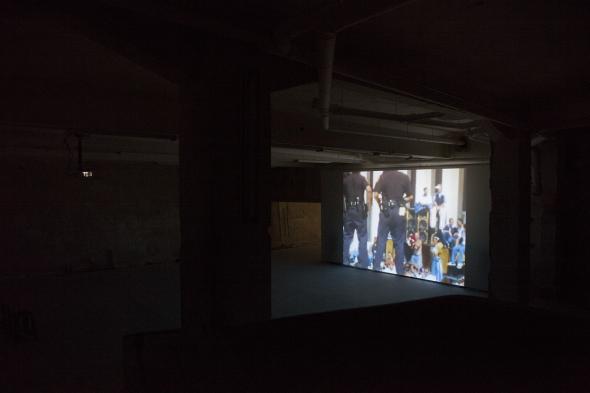 Untitled (Zimbabwean Queen of Rave), 2005, de Dan Halter
Untitled (Zimbabwean Queen of Rave), 2005, de Dan Halter
Everybody´s free, the name of a mythical song from the 90s, is affirmed as a political and visual strategy in Untitled (Zimbabwean Queen of Rave), 2005, by Dan Halter. The juxtaposition of images used by the artist confronts young white people dancing on too of flat-bed trucks, rave parties and outdoor spaces – documented records of partying masses – with colonized and impoverished mobs protesting and rallying on the streets. Between the rave parties, the dominant order rituals to idolize pleasure, and the demonstrations of the population demanding fundamental rights, the video piece witnesses the way in which these televised movements were emptied from their original political meaning. If the capacity for revolt cannot be stolen, it is the police that stamps its presence throughout all scenes. It is the police that insures that a body in free movement is not always a liberated body.
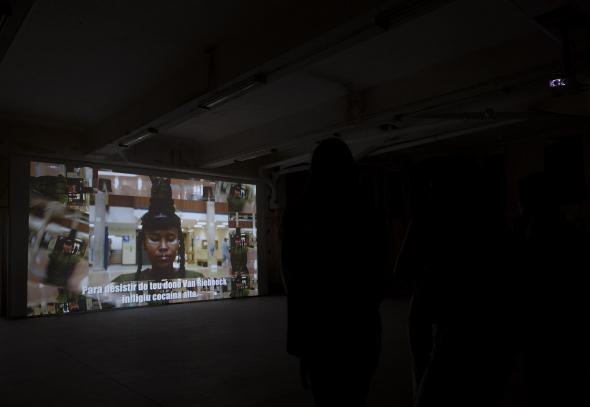 Mamoloyi Revival, 2017, de Melebona Maphtuse,
Mamoloyi Revival, 2017, de Melebona Maphtuse,
Mamoloyi Revival, 2017, by Malebona Maphtuse utilizes digital collage to re-enforce her political effect of de-familiarization. As a member of the collective Title in Transgression, with Simnikiwe Buhlungu, Dineo Diphofa and Boitumelo Motau, Maphtuse operates a radical critique of the colonization process understood as horizontal in every social field. The space occupied by the arts, the structures, discourses and agents that configure it are an integral part of this process of subjection. Denouncing the opposition constructed between the traditional African beliefs, and Christianity of the West, this video piece establishes a network of equivalents in space and time between events. The politicization of space and of the bodies that move through it reminds us of the apartheid. But this is only the departing point to the construction of a visual essay whose critical dimension lies in the refusal of linear history, providential and euro-centric, the concept at the base of Western civilization. We are left with time, a kind of contracted time, the time of coexistence.
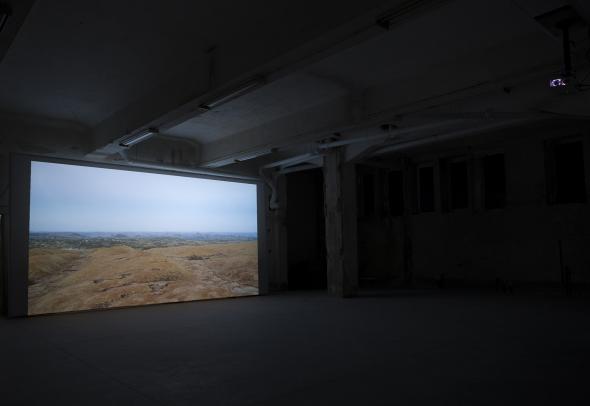 End of History III, 2014, Thenjiwe Niki Nkosi
End of History III, 2014, Thenjiwe Niki Nkosi
Thenjiwe Niki Nkosi states in several interviews that the prospect of pan-Africanism is for her a deeply rooted desire. Among the many reasons for this wish is the unity of her family. End of History III, 2014, retakes the memory of the sea, the Atlantic Ocean that her father crossed to find exile in South Africa, the shores of the Black Sea where her maternal grandparents lived or the sea that the artist herself had to cross as a child. The Zulu myth evoked by the artist, tells us that all stories come from the ocean. The ocean that is both separation and unity; just like the sky, just like borders. They all become transient sites between successive departure and return flights. In these journeys, the dense white clouds that (un)cover reality, seem to signify the silence or the invisibel in narratives and in ideological forces. Everything is built, be it architecture, the landscape or history itself. With history, we learn that totalitarian experiences can end up in doom. Storms also happen at sea.
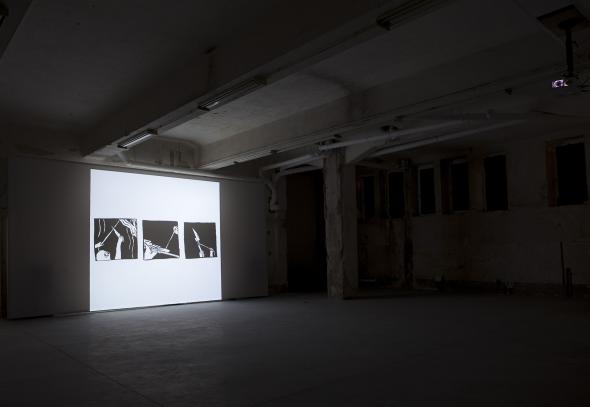 Exquisite Corpse, 2015, de Jonah Sack
Exquisite Corpse, 2015, de Jonah Sack
A man without a head commits a murder, drives a tractor and dances to the sound of a jukebox. Taking as reference a game frequently practiced by the surrealists, cadavre exquis, Jonah Sack shows us the animation video, Exquisite Corpse, 2015. Using multiple drawings that keep being replaced at a deliberate pace and creating a grid, this body, as a cartoon, seeks to have fun at a bar full of people. Graphically and visually, the work resembles the essence of the collective drawing proposed by the cadavre exquis, as well as the liberation from all moral intentions. Since the head remains, in orthodox understanding, the place of reason, this man without head, and in psychic automatism, does not represent any act of freedom, but rather, the exercise of violence in its most arbitrary form. This visual dialogue establishes that good and evil are illusory mirages, even when we assume that we fully understand them. This is how we write our fragility.
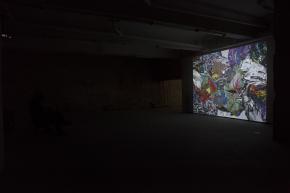
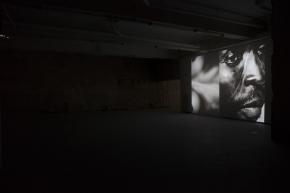 Love, unrequited' de Nkiruka Oparah
Love, unrequited' de Nkiruka Oparah
Nkiruka Oparah, a founding member of the 5/5 Collective 5/5, presents Love, unrequited, 2014, exploring the interactions between cultural memory and cosmological representations of his country, Nigeria, as well as issues of racial subordination, identity and belonging. Through an bold visual language, showcasing the practice of collage, the artist uses a variety of materials from different sources to construct multimedia portraits that assume multiple semantic configurations. The artificiality of the reality that she represents, which the tool of collage renders possible, gives the work its political strength. Juxtaposing images of paradise islands, idealized nature, hallucinations of the mind and bodies that outlive other places, these fragments or assemblage-portraits seek a mutual connection. They seek the senses, and to make sense. They are like love stories that always hide other stories. The night is dark and belongs to a horror story.
To radically affirm the freedom of being a feminist, to deconstruct the language of patriarchy and phallocentrism constitutes the artistic program of Lunga Ntila. Starting from the body as a political space, the artist frames the discussion about corporal control as an expression of social control. In Ode to my lover, 2018, each (re)cut and (re)pasted icon-fragment becomes a form of direct action, in the tradition of feminist, ethnic minority and homosexual movements who claim their civil rights and place identity and individuality at central stage. The exploration undertaken by women, artists and non-artists, expresses the invisibility to which they have been condemned for centuries. As a manifest against oppression, this compromised body asserts itself as the conceptual stage of the ideological, social, political, and sexual contradictions that work through it. Fifteen seconds is enough to mean freedom.
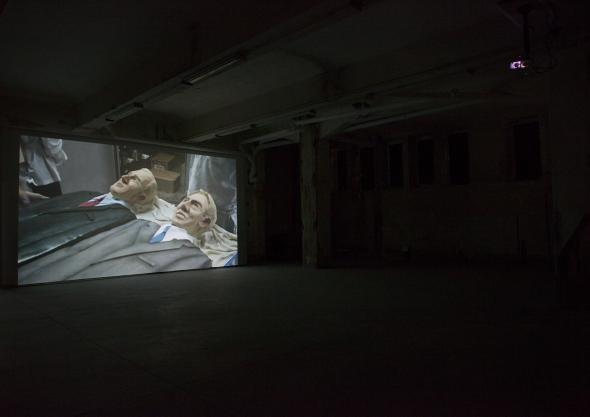 An Indigestible Desert, 2008, de Reza Farkondeh e Ghada Amer
An Indigestible Desert, 2008, de Reza Farkondeh e Ghada Amer
An Indigestible Desert, 2008, by Reza Farkondeh and Ghada Amer, is a video that records a performance during which we watched the creation of a cake with the images of the bodies of Tony Blair and George W. Bush. The heads, hands and feet of the two politicians are hollow and made of chocolate. White chocolate. The filling is red. Red as blood. As the performance unfolds, you hear Arabic music, guests enter and sit down. After a kind of ritualized prayer consecrated to those leaders, Amer begins to smash their heads with a hammer. Everyone begins to help themselves and eat. This anthropophagic move, seems to become an initiatory rite that is both cathartic and solemn. Heroes become twofold, the object of identification and the death drive. It is said that some tribes ate the flesh of prisoners from other tribes in order to avenge their ancestors who had been killed by them. The story has no end.
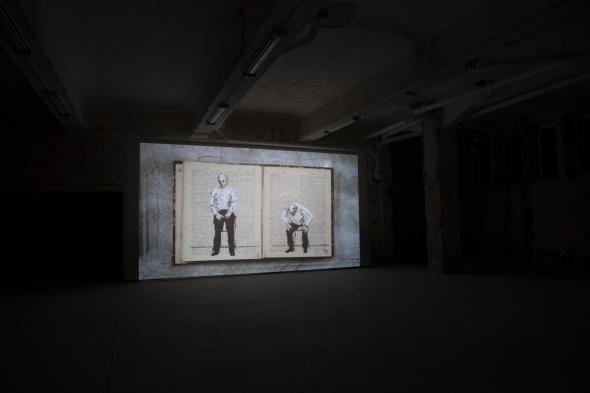 Tango for Page Turning, 2012-2013, de William Kentridge
Tango for Page Turning, 2012-2013, de William Kentridge
Tango for Page Turning, by William Kentridge, 2012-2013, which integrates the work Refuse the Hour, places us at the center of the political heritage of colonialism through an ancient book on Applied Chemistry, whose pages turn successively and swiftly. Throughout this history of melancholy, as time, sound, image and dance communicate with each other and affect each other, the text reconfigures the space and the composition. Among fragments and constant edits that constitute a metaphors of the workings of our memory, and of the perception and the metamorphosis of the world, this animated narrative reflects about collaborative processes. Small stains, phrases, symbols, drawings, accidents, levitate and collide on the blurred text, while the sound, repetitive, manipulated and also fragmented, interrupts, and thus makes impossible, any linear order. The lesson in this book, not unlike that of the revised edition of Edward Muybridge’s experiments on animal locomotion, tells us that history is a brute force, and that it always waits around to be danced with.
Although not part of the Lost Lover exhibition, Grada Kilomba’s installation Illusions Vol. II, Oedipus, 2018, comissioned by the 10th Berlin Biennale, is part of Lara Koseff’s curatorial program at Rampa. Presented autonomously in a separated gallery room, the work revisits the myth of Oedipus, orchestrating the languages of video, performance and text. In this narrative, the tragic destiny lies in the continuous repression of colonial patriarchy, in this original ontological failure that turned into punishment. The re-framing of the prophecy becomes an ethical bargain. Bertolt Brecht’s lesson comes to mind in a context where those who speak matter. The strategy of distance and estrangement, which conceptually and formally underlies the whole work, operates the necessary denaturalization and denounces the ideology behind reality. This is a non-Aristotelian dramatic theater. There is no longer a metaphysical problem, the Oedipus is not only social but also a historical representation that was politically constructed. The greatest challenge is to deconstruct the word, and use it against itself.
If at the beginning of this text we ask what happens to all those who think outside of the legitimized and European structures of philosophy. We may also ask what happens to artists who work away from the canons and global marketing. Lost Lover is not just a sign posted on the walls and streetlights of the streets of Johannesburg. Lost Lover is our time.